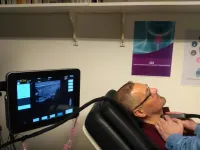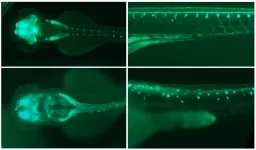Zhores supercomputer helps Skoltech researchers model new method of generating gamma-ray combs
2021-06-01
(Press-News.org) Skoltech researchers used the resources of the university's Zhores supercomputer to study a new method of generating gamma-ray combs for nuclear and X-ray photonics and spectroscopy of new materials. The paper was published in the journal Physical Review Letters.
A gamma-ray comb is a series of short bursts that, when plotted as intensity versus frequency, look like sharp and equally spaced teeth of a comb. Generating these combs at high brightness in the gamma-ray domain has been challenging because of something called ponderomotive spectral broadening - an effect that destroys the monochromaticity that allows gamma-ray sources to be used in nuclear spectroscopy, medicine, and other applications.
Sergey Rykovanov and Maksim Valialshchikov from the Skoltech High Performance Computing and Big Data Laboratory as well as Vasily Kharin from Genity LLC offered a way to avoid this effect. To obtain the calculations needed to support this result, they used the Zhores supercomputing cluster at Skoltech.
"Our idea relies on a method that is very well known in the attosecond community--to use laser pulses with temporally varying polarization (with circular polarization in the wings and linear polarization only in the middle of the pulse) to gate emission of harmonics only to the part of the pulse where the polarization is linear," the authors write.
"Polarization gated pulses limit harmonics emission only to the region around the center of the pulse, where intensity gradients are smaller and harmonics emission efficiency is higher. Both of these lead to smaller ponderomotive broadening," Rykovanov says.
Maksim Valialshchikov adds that, to run the tests necessary to confirm their results, the scientists needed a simulation with large number of particles. "Zhores provides a large number of CPUs, and using part of them allows completing a single simulation orders of magnitude faster than using a single laptop," he notes.
According to Rykovanov, the authors plan to conduct additional research regarding the impact of radiation friction and quantum effects on the visibility of gamma comb. "This will allow us to move towards the experimental observation of the proposed effect in the nearest future," he says.
The authors say their proposed method can be used in photonuclear experiments as well as nonlinear quantum electrodynamics experiments planned at DESY, the German particle accelerator research center, and SLAC National Accelerator Laboratory in the US.
INFORMATION:
ELSE PRESS RELEASES FROM THIS DATE:
2021-06-01
The intriguing chemistry and biology of sulfur?containing natural products from marine microorganisms (1987-2020)
https://doi.org/10.1007/s42995-021-00101-2
Announcing a new publication for Marine Life Science & Technology journal. In this review article the authors Yang Hai, Mei?Yan Wei, Chang?Yun Wang, Yu?Cheng Gu and Chang?Lun Shao from Ocean University of China, Qingdao, China and Syngenta Jealott's Hill International Research Centre, Berkshire, UK consider the chemistry and biology of sulfur?containing natural products from marine microorganisms.
Natural products derived ...
2021-06-01
The National Institute of Polar Research (NIPR) publishes Polar Science, a peer-reviewed quarterly journal dealing with polar science in collaboration with the Elsevier B. V.. The most recent issue (Vol. 27 published in March 2021) was a special issue entitled "Arctic Challenge for Sustainability Project (ArCS)," which featured the former national (nation-wide) Arctic research project in Japan. The full text of this issue is freely accessible worldwide for a limited time until 10 September 2021.
The Arctic Research Project "Arctic Challenge for Sustainability (ArCS)" was carried out from September 2015 to March 2020 as a national flagship project funded by the Ministry of Education, Culture, Sports, ...
2021-06-01
In past studies, researchers have found that C. elegans gonads generate more germ cells than needed and that only half of them grow to become oocytes, while the rest shrinks and die by physiological apoptosis, a programmed cell death that occurs in multicellular organisms. Now, scientists from the Biotechnology Center of the TU Dresden (BIOTEC), the Max Planck Institute of Molecular Cell Biology and Genetics (MPI-CBG), the Cluster of Excellence Physics of Life (PoL) at the TU Dresden, the Max Planck Institute for the Physics of Complex Systems (MPI-PKS), the Flatiron Institute, NY, and the University of California, Berkeley, found evidence to answer the question of what triggers this cell fate decision between life and death in the germline.
Prior studies ...
2021-06-01
Researchers from Trinity College Dublin have developed a novel set of tools for designing vitamin D clinical trials that capture large seasonal and population-wide differences in vitamin D status, typically seen in individuals. Their study published in the journal Scientific Reports (today, Monday 31st May 2021) provides a framework for clinical trials to establish whether vitamin D supplementation is effective against a given disease.
The study also reveals that many trials which failed to find any association between vitamin D and disease prevention may have been underpowered or conducted without enough subjects to detect a benefit of vitamin D.
You can read the full journal paper here: https://go.nature.com/3uERjgO
The ...
2021-06-01
YouTube is a treasure trove of virtual reality fails: users tripping, colliding into walls and smacking inanimate and animate objects. By investigating these "VR Fails" on YouTube, researchers at the University of Copenhagen have sought to learn more about when and why things go sideways for users and how to improve VR design and experiences so as to avoid accidents.
Millions of YouTube viewers have enjoyed hearty laughs watching others getting hurt using virtual reality - people wearing VR headsets, falling, screaming, crashing into walls and TV sets, or knocking spectators to the floor. Some of us have even been that failing someone. Now, videos of virtual reality mishaps, called "VR Fails", ...
2021-06-01
Redox-flow batteries store electrical energy in chemical compounds that are dissolved in an electrolyte. They are a particularly promising alternative to lithium-ion batteries as stationary energy storage. A team headed by Prof. Dr. Ingo Krossing from the Institute of Inorganic and Analytical Chemistry at the University of Freiburg has succeeded in developing a non-aqueous All-Manganese Flow battery (All-MFB) that uses sustainable manganese as its active material and has a long cycle life. The researchers present the results of their work in the latest edition of Advanced Energy Materials.
Active materials are ...
2021-06-01
Energy communities will play a key role in building the more decentralised, less carbon intensive, and fairer energy systems of the future. Such communities enable local prosumers (consumers with own generation and storage) to generate, store and trade energy with each other -- using locally owned assets, such as wind turbines, rooftop solar panels and batteries. In turn, this enables the community to use more locally generated renewable generation, and shifts the market power from large utility companies to individual prosumers.
Energy community projects often involve jointly-owned assets such as community-owned wind turbines or shared battery storage. Yet, this raises the question of how these assets should be controlled - often in real time, and how the energy outputs jointly-owned ...
2021-06-01
Thyroid nodules are a common pathology having a prevalence of 19-76% when screened with ultrasound, with higher frequencies in women. Current medical methods used to assess the malignancy of a nodule consist in performing an ultrasound, followed by a Doppler ultrasound, and then a biopsy. However, unfortunately, these methods present both low specificity and low sensitivity. This insufficient effectiveness in accurately being able to diagnose thyroid tumors leads to many unclear or unnoticed cases as well as many others that undergo unnecessary surgeries (false positives) and increase the cost ...
2021-06-01
When the Augustinian monk Gregor Mendel crossed white-flowering with purple-flowering pea plants in the mid-19th century, he made an interesting discovery: The offspring were all purple. He therefore called this trait dominant, while the white blossom color was recessive. The reason for this phenomenon: In peas, each gene occurs twice. One version comes from the maternal plant and the other from the paternal plant. If a pea has inherited the gene for purple flower color from one parent, but the gene for white flower color from the other, purple wins. Only when two genes for white flowers come together in the offspring plant is it white.
Humans also have genes that are inherited either dominantly or recessively. However, the case is not so clear for the mutations investigated ...
2021-06-01
Using a Fitbit and a spy mic, scientists have discovered new insight into the behaviour of the elusive Canada lynx. A new study by researchers from McGill University, University of Alberta, and Trent University provides a first look at how miniaturized technology can open the door to remote wildlife monitoring.
"Working on one of the boreal forest's top predators, the Canada lynx, we found that two different technologies, accelerometers and audio recording devices, can be used to remotely monitor the hunting behaviour of predators, even documenting the killing of small prey," says lead author Emily Studd, a Postdoctoral Fellow under the supervision of Murray Humphries at McGill University and Stan Boutin at University ...
LAST 30 PRESS RELEASES:
[Press-News.org] Zhores supercomputer helps Skoltech researchers model new method of generating gamma-ray combs






